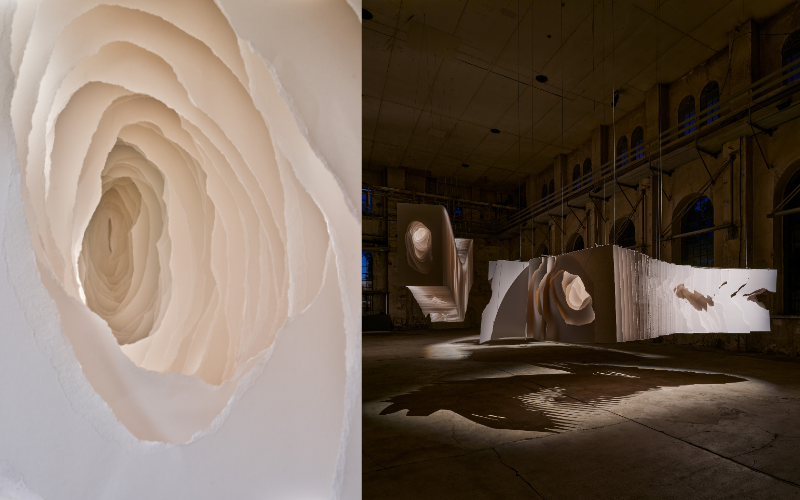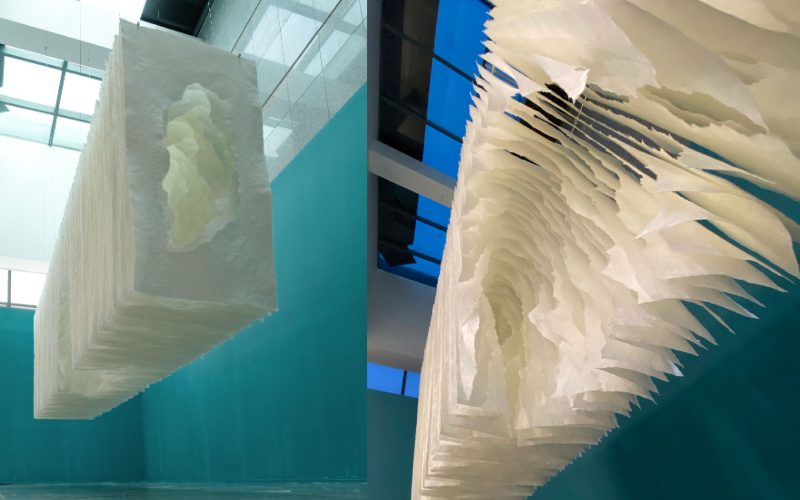- 한국어
- English
- 日本語
- 中文
- العربية
- Español
- Français
- Deutsch
- Pусский
- Tiếng Việt
- Indonesian
By Honorary Reporter Foteini Chatzoudi from Greece
Angela Glajcar, a contemporary artist from Mainz, Germany, is known for her innovative use of paper, particularly the traditional Korean paper Hanji. Specializing in 3D sculptures, she transforms large, torn sheets of paper into intricate layered forms, often suspended to interact with light and shifting perspectives.
Her use of Hanji's transparency and torn edges creates a mesmerizing interplay of light and shadow, adding depth and dimension to her sculptures.
Glajcar's works have been showcased globally including at the Jeonbuk Museum of Art and Kiaf Seoul in Korea, Bluerider Art London, Friedrichs Pontone Gallery in New York, Haus des Papiers (House of Paper) in Berlin and Meb Arte Studio in Italy.
Among her awards are the Paper Art Award (2021) from Haus des Papiers, Mainzer Stadtdrucker Award (2014-15), Audience Award at the Regionale (2010) from the Wilhelm-Hack-Museum and Phoenix Art Award (2006).
The following are excerpts from an email interview with the artist from Nov. 27 to Dec 10.
What does Hanji have over other paper types?
I first worked with Hanji in 2021. Even after decades of working with paper, Hanji opened a completely new horizon for me. The tearing process is more challenging due to the long fibers, which makes it distinct from any other paper I've used. I love its unique qualities and have continued to work with it since.

On the left is a close-up of Angela Glajcar's work "Flashback," with the wider shot (right) shown at an exhibition hosted by Kunstraum Dornbirn in Austria. (Gunter Richard Wett)
How do you use Hanji's properties to create large-scale pieces?
The paper is very light and I wrinkle an entire sheet to create a uniform surface. After I smooth the sheets, I use them layer by layer. My installations grow into the space sheet by sheet. This allows me to build large monumental formats from relatively small sheets.
How does the tearing process influence the final form and meaning of a piece?
Tearing is probably the most natural way of processing paper. It shows Hanji's underlying structure, exposing its fibers and creating distinctive torn edges. The inside of the material becomes perceptible. My work is always about interior and exterior space and our relationship to it. The material reinforces this approach through its own structure.

Hanji artwork at Jeonbuk Museum of Art in Wanju-gun County, Jeollabuk-do (Jeonbuk) Province (Angela Glajcar)
What does Hanji mean to you?
I've always enjoyed experimenting with different types of paper, and Hanji has been particularly unique and exciting. Other types of paper have creases that disrupt the smooth surface, but I embrace the creases in Hanji. Its textile-like quality almost resembles fabric, which adds a whole new dimension to my work. Hanji’s versatility and texture are what make it so special to me.
What do you want to convey through your art?
I want to make the connection to space tangible and highlight how space affects us. My installations invite viewers to rediscover space and encourage reflection on the spaces we occupy and how we move within them. These works offer new ways to perceive and experience space, challenging our senses, especially the unconscious sixth sense that governs our physical perception of it.
What are your plans?
I dream of exploring new spaces and continually seeking out new types of paper to activate our senses. I'm planning several museum exhibitions in 2025 and am excited over what's next.
msjeon22@korea.kr
*This article is written by a Korea.net Honorary Reporter. Our group of Honorary Reporters are from all around the world, and they share with Korea.net their love and passion for all things Korean.